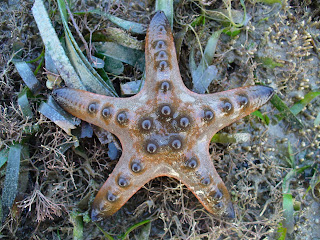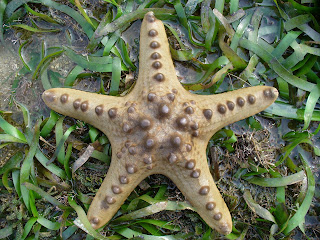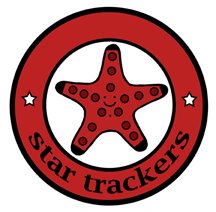Abundance, Spatial Distribution, and Size Structure of the Sea Star Protoreaster nodosus in Palau, with Notes on Feeding and Reproduction
Scheibling, R. E. & Metaxas, A., 2008.
Bulletin of Marine Science 82(2): 221-235
Abstract
Protoreaster nodosus (Linnaeus, 1758) is a common sea star in shallow sand and seagrass habitats in the tropical Indo-pacific region. It has been extensively harvested as an ornament, but little is known of its biology and ecology. We quantitatively sampled populations at five sites in palau to obtain baseline information on abundance, spatial distribution, and population structure of this species in areas unaffected by human depredation. Density on sand bottoms ranged from 4 to 32 individuals 100 m-2 and biomass from 3.1 to 20.7 kg 100 m-2. Population size estimates at two locations were 100 and 630 individuals. Mean size (radius) of individuals ranged from 14 to 16 cm among populations, and was negatively related to density. Density was greatest in a seagrass bed (51 individuals 100 m-2, 12.3 kg 100 m-2) where the population was composed of juveniles (8-12 cm). Spatial distribution of sea stars in each population was random, as indicated by nearest-neighbor distance. Manipulations of density and spatial distribution, performed by removing or by adding and centrally aggregating individuals in circular plots (78.5 or 314 m2), showed that sea stars reestablish pre-manipulation densities and nearest-neighbor spacing within 2-5 d. Protoreaster nodosus feeds on meiobenthos and microbial/microalgal films by extra-oral ingestion of sediments and seagrass. The incidence of daytime feeding is generally high (> 60% of individuals), suggesting these sea stars are important consumers and bioturbators in sedimentary habitats. Synchronous spawning occurred at full moon (in May) in the laboratory, yielding planktotrophic larvae.
Scheibling, R. E. & Metaxas, A., 2008.
Bulletin of Marine Science 82(2): 221-235
Abstract
Protoreaster nodosus (Linnaeus, 1758) is a common sea star in shallow sand and seagrass habitats in the tropical Indo-pacific region. It has been extensively harvested as an ornament, but little is known of its biology and ecology. We quantitatively sampled populations at five sites in palau to obtain baseline information on abundance, spatial distribution, and population structure of this species in areas unaffected by human depredation. Density on sand bottoms ranged from 4 to 32 individuals 100 m-2 and biomass from 3.1 to 20.7 kg 100 m-2. Population size estimates at two locations were 100 and 630 individuals. Mean size (radius) of individuals ranged from 14 to 16 cm among populations, and was negatively related to density. Density was greatest in a seagrass bed (51 individuals 100 m-2, 12.3 kg 100 m-2) where the population was composed of juveniles (8-12 cm). Spatial distribution of sea stars in each population was random, as indicated by nearest-neighbor distance. Manipulations of density and spatial distribution, performed by removing or by adding and centrally aggregating individuals in circular plots (78.5 or 314 m2), showed that sea stars reestablish pre-manipulation densities and nearest-neighbor spacing within 2-5 d. Protoreaster nodosus feeds on meiobenthos and microbial/microalgal films by extra-oral ingestion of sediments and seagrass. The incidence of daytime feeding is generally high (> 60% of individuals), suggesting these sea stars are important consumers and bioturbators in sedimentary habitats. Synchronous spawning occurred at full moon (in May) in the laboratory, yielding planktotrophic larvae.




































































